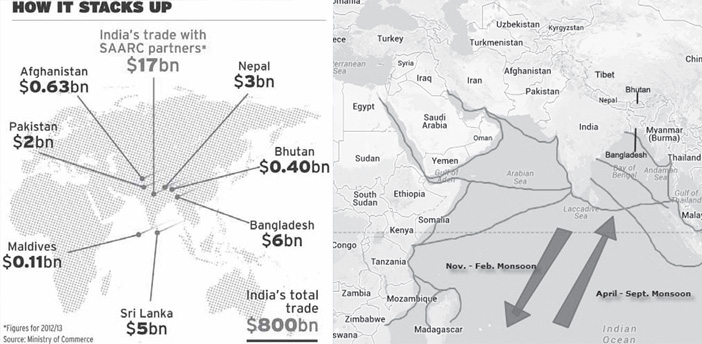Before there was even a hint of the dawn of civilisation in much of what is today’s sophisticated society, the ancient people of the land we now recognise as India were trading across the seas and far in-road from its many shores. The cosmopolitan dwellers from the valley between the Indus and the since dried-up Saraswati River were an industrious and adventurous people travelling and exchanging freely with neighbours, and even lands which all those thousands of years ago must have seemed just as far and dangerous to get to, as the moon does, to us Earthlings!
Be it ultra modern civilisations, enterprising tribal traders, or the family that shifts into the empty flat across the landing; the first outreach into the world has always been the immediate neighbour. From the much eulogised bowl of sugar on a personal level to its national counterpart of electricity or oil – in distress and in good times, to the neighbour is where one goes. Across history of the area we call India, all neighbouring kingdoms and empires have traded with as much gusto as they have warred with their neighbours.
Officially, India shares her land borders with seven countries – Afghanistan, Pakistan, China, Bhutan, Nepal, Bangladesh and Myanmar. A couple of clarifications – Tibet is recognised as an Autonomous Region of China by the Indian government and while India claims a land border with Afghanistan through northwestern undivided Kashmir, that region is under Pakistani control and hence excluded from the scope of countries with a contiguous land border.
The demise of the famous Grand Trunk Road
Two thousand years before these complications arose, a road is believed to have shaped itself by the tireless treading of human feet; which connected the ends of the Indian subcontinent. Stretching from Chittagong in present day Bangladesh, it wound its way up to today’s Kabul in Afghanistan. One of south Asia’s longest and oldest roads, it has been known by many names like Uttara Patha, Badshahi Sadak and Sadak-e-Azam, but the most popular name for this 2500 kms long continuum is the Grand Trunk Road.
Renovated and extended by Sher Shah Suri in the sixteenth century, the Sadak-e-Azam carries a baggage of history like few others, and stoically remains, in Kipling’s words, “Such a river of life as nowhere else exists in the world”. Known to European travellers as ‘the long walk’, this grand road has today selflessly merged itself into the road networks of the countries it traverses, and remains one of the backbones of surface transport in the Indian subcontinent. Outcrops from this subcontinental highway would rise up to meet the famous Silk Route.
The geographical continuum of the area of the Indian sub-continent is packed with almost every imaginable resource required for necessity or luxury. Yet, the utility and traffic along its entire length has scarcely seen a fragment of the activity it was once renowned for. The chief contributor to this disruption were the arbitrary lines Lord Cyril Radcliffe drew across a map in the five weeks he had to split the ‘jewel in the British Raj’. What transpired in 1947 was the ludicrous formation of a country separated by the entire width of India. The independence of India did to the Trunk Road what the ascendancy of the Ottomans did to the Silk Route in 1453 – effectively closed a route that had outlived empires, plagues and wars.
Trade across the seas
Across the ocean, Sri Lanka is the closest neighbour, followed by Indonesia, whose northern island of Aceh is just 150 kms from India’s southernmost land mass — Indira Point in the Nicobar Islands. The coastline stretches such that the immediate neighbours Pakistan, Bangladesh and Myanmar have always been important sea-trade partners.
Long before Europeans “discovered” the Indian Ocean, from at least the 3rd century BCE, traders from India’s coastal areas used triangle-sailed dhows to harness the seasonal monsoon winds as ideas, goods and people moved freely across a web of sea routes that connected India, Arabia, East Africa, South- East and East Asia, including China. From the Indus Valley, people traded with Mesopotamia and Afghanistan, the Indians traded with the Romans, the Cinnamon Route that linked south-east Asia with East Africa or the many trade routes across the Bay Of Bengal, which connected the kingdoms across the Indian Ocean, maritime trade was a well developed and fully functional system. More intricate and perhaps older and more voluminous than its land counterpart – the Silk Route; the fall of which, quite unpredictably set the tone for the demise of these sea connections as well.
With the closure of the Silk Route, Portuguese sailors under Vasco da Gama rounded the southern point of Africa and ventured into new seas. The Portuguese were eager to join in the Indian Ocean trade, as the Europeans still craved Asian goods. However, Europe had precious little to barter with. The people of the subcontinent and further south had no need of wool or fur clothing or the other meagre products of Europe.
Quite predictably, the Portuguese then entered the market more as pirates than traders, using a combination of bravado, cannons and extortion to gain a foothold in the ocean trade. They were quickly followed by the Dutch East India Company, which sought a total monopoly over the trade of spices. Close on heels came the British East India Company, and the Europeans fought a diplomatic and often violent battle for the supremacy of the Indian Ocean. The British came out the better in this and as the thriving economies of Asia were transformed into colonies, reciprocal trade dissolved with goods moving increasingly to Europe.
The isolation of South Asia
From being an elaborate network of symbiotic co-existence, to fenced off islands of isolation and indifference, bordering on mutual loathing, South Asia has walked down a long and dangerous dark road of divide based on ridiculous vanities. Today, South Asia is one of the least economically integrated regions in the world.
It is absurd that except China, no neighbouring country finds itself in the top 10 list of trade partners with India. It is laughable that we use 1000 km long diversions to travel within our own country in deference to some imaginary lines. It is contrary to every sense of business or trade that we import at higher costs from distant countries while refusing to trade with our neighbours. It is frustrating to not visit places we grew up learning about. It is heartbreaking that dwellers of the subcontinent cannot visit the places of their family’s origins because it is on the ‘other side’.
It is up to us to realise that we are not isolated rocks, and the chasms that separate us are only illusions. It is true we are all glorious individual waves, but we must bring back the memory that we are also the ocean.


